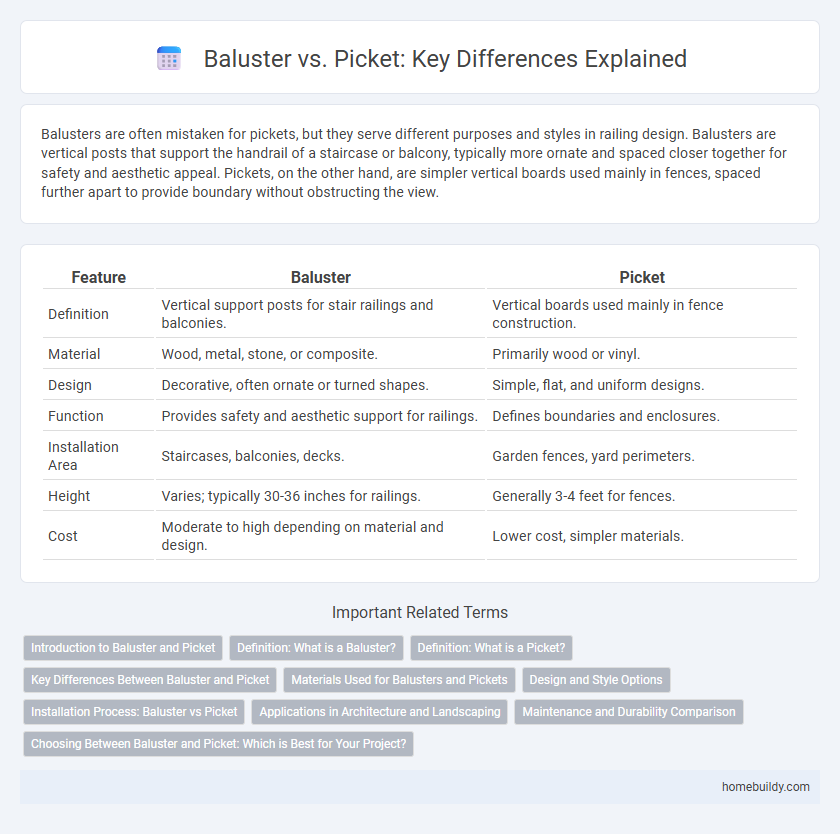Balusters are often mistaken for pickets, but they serve different purposes and styles in railing design. Balusters are vertical posts that support the handrail of a staircase or balcony, typically more ornate and spaced closer together for safety and aesthetic appeal. Pickets, on the other hand, are simpler vertical boards used mainly in fences, spaced further apart to provide boundary without obstructing the view.
Table of Comparison
| Feature | Baluster | Picket |
|---|---|---|
| Definition | Vertical support posts for stair railings and balconies. | Vertical boards used mainly in fence construction. |
| Material | Wood, metal, stone, or composite. | Primarily wood or vinyl. |
| Design | Decorative, often ornate or turned shapes. | Simple, flat, and uniform designs. |
| Function | Provides safety and aesthetic support for railings. | Defines boundaries and enclosures. |
| Installation Area | Staircases, balconies, decks. | Garden fences, yard perimeters. |
| Height | Varies; typically 30-36 inches for railings. | Generally 3-4 feet for fences. |
| Cost | Moderate to high depending on material and design. | Lower cost, simpler materials. |
Introduction to Baluster and Picket
Balusters are vertical posts that support the handrail of a staircase or balcony, typically crafted from wood, stone, or metal, and designed to combine structural stability with ornate detailing. Pickets, commonly used in fencing, are simpler vertical boards spaced evenly to create a barrier or enclosure, emphasizing functionality and straightforward design. While balusters enhance architectural aesthetics and safety in railings, pickets primarily serve as practical elements for perimeter definition and security.
Definition: What is a Baluster?
A baluster is a vertical, often decorative post that supports the handrail of a staircase or balcony, designed to provide safety and structural stability. Unlike a picket, which is generally a simpler vertical slat used in fencing, balusters tend to have a more intricate design and are specifically crafted for architectural and interior applications. Materials used for balusters include wood, stone, metal, and composite, allowing for varied styles and durability in both indoor and outdoor settings.
Definition: What is a Picket?
A picket is a vertical element typically used in fencing, characterized by its uniform, narrow, and pointed shape designed for boundary marking and security. Unlike balusters, which are often thicker and feature ornamental designs supporting a railing, pickets serve primarily as functional components in picket fences. Pickets are commonly spaced evenly and constructed from wood, vinyl, or metal to create a continuous barrier while allowing visibility.
Key Differences Between Baluster and Picket
Balusters are vertical posts typically used in staircases and balcony railings to provide support and decorative appeal, often featuring intricate designs and varied shapes. Pickets are simpler, narrower vertical boards commonly found in fences, serving primarily as a barrier for privacy or security rather than structural support. The key differences between balusters and pickets lie in their functional purpose, design complexity, and typical usage locations--balusters prioritize ornamental support while pickets focus on straightforward fencing utility.
Materials Used for Balusters and Pickets
Balusters are commonly crafted from materials such as wood, wrought iron, aluminum, and stone, offering durability and aesthetic versatility for staircases and railings. Pickets, primarily found in fencing, are typically made from wood, vinyl, or metal, emphasizing weather resistance and ease of installation. The choice of materials for balusters often prioritizes structural strength and decorative appeal, while pickets focus more on outdoor resilience and cost-effectiveness.
Design and Style Options
Balusters offer a wide range of design and style options, including ornate, classic, and modern profiles that can be crafted from wood, metal, or stone, enhancing architectural aesthetics. Pickets typically feature simpler, uniform shapes primarily used in fencing, reflecting a more utilitarian design with limited stylistic variations. Choosing balusters over pickets provides greater customization for handrails and staircases, allowing for intricate detailing and diverse finishes.
Installation Process: Baluster vs Picket
Baluster installation requires precise measurement and alignment to ensure uniform spacing and secure attachment to handrails and stair treads, often involving drilling and anchoring for stability. Picket installation is generally simpler, involving evenly spaced vertical slats attached directly to a horizontal rail or frame, often with nails or screws, making it faster and less labor-intensive. Choosing between balusters and pickets depends on the desired design complexity and installation time, as balusters demand more precision and skill.
Applications in Architecture and Landscaping
Balusters, typically used in staircases and balconies, provide both structural support and ornamental appeal, enhancing architectural aesthetics with their robust and often intricate designs. Pickets are primarily utilized in fencing, offering straightforward vertical elements that define boundaries and provide security in landscaping applications. The choice between balusters and pickets depends on whether the focus is on decorative railings or functional perimeter fencing in architectural and landscape projects.
Maintenance and Durability Comparison
Balusters are typically crafted from materials like metal, stone, or fiberglass, offering superior durability and lower maintenance requirements compared to wooden pickets, which are prone to weathering and rot. Metal or fiberglass balusters resist corrosion and fading, requiring only occasional cleaning, whereas pickets often need regular painting or staining to prevent deterioration. The longevity of balusters makes them a cost-effective choice for long-term use in fencing and railing systems, outperforming the maintenance demands of traditional pickets.
Choosing Between Baluster and Picket: Which is Best for Your Project?
Balusters, typically used in staircases and railings, offer a more decorative and sturdy option compared to pickets, which are commonly found in fences and provide a simpler, vertical slat design. When choosing between baluster and picket, consider the architectural style, durability requirements, and the level of safety or privacy needed for your project. Balusters suit intricate designs and enhanced support, while pickets are ideal for cost-effective fencing with straightforward aesthetics.
baluster vs picket Infographic

 homebuildy.com
homebuildy.com